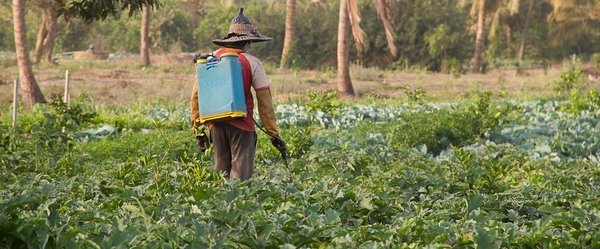 Read this article in French
Read this article in French- Share this article
- Subscribe to our newsletter
Using agroecology to protect crops: the zero-pesticide farming challenge
Many researchers are interested in and have begun developing crop protection approaches that either partly or totally cut pesticide use under certain conditions. These approaches include agroecological crop protection (ACP).
“The aim is to apply the principles of agroecology to crop protection,” says Jean-Philippe Deguine, an agroecologist at the French research institute CIRAD in Montpellier, who coordinated the article“Agroecological crop protection for sustainable agriculture”. This relies on two of the basic principles of agroecology – making use of biodiversity and boosting soil health – and the founding principle of crop protection: using prevention rather than cure to fight pests. Prevention is about using disease-tolerant or disease-resistant varieties, appropriate farming practices, and a combination of agronomic solutions.
“Unlike pesticides, which are licensed and must be used against a specific type of pest, ACP can be used on a whole territory or agrosystem and against all pests. It creates a virtuous circle where biodiversity is used to boost agrosystem health,” Deguine adds.
The study, which was led by INRAE (l’Institut national de recherche pour l’agriculture, l’alimentation et l’environnement) with the participation of CIRAD, revealed a strong link between plant diversity and natural pest regulation (insect pests, weeds and pathogenic fungi). ACP can maintain or improve agricultural yields (by reducing pest damage), ensure healthy food, reduce the negative impacts of farming on the environment and human health (zero pesticides), and help make farms more economically viable. The authors summarise the knowledge acquired and suggest ways of rolling out ACP.
“The concept can be applied all over the world, provided local specificities are taken into account,” says CIRAD agronomist Nadine Andrieu, one of the article’s co-authors. “Two-way knowledge sharing between scientists and farmers is vital. But public policy must provide significant support to ensure the necessary technical and organisational changes.”
It takes time to implement ACP
Public policy must also allow for the time needed to implement ACP in farming systems. This involves a transitional phase that can last several years and comprises joint field diagnoses, participatory redesigns of cropping systems, farmer training and coordination of stakeholders.
“We need to move away from the current short-term mindset and take the time to recreate biological equilibria within agroecosystems. The sooner we start, the sooner those new systems will be able to address the current issues facing farming,” CIRAD agronomist Eric Scopel says.
This article, signed by 56 scientists, including more than 40 from French organisations, expresses the clear scientific consensus in France around ACP. It includes some 300 bibliographical references from every continent and opens up new prospects for application and research.
(CIRAD/wi)
Reference





Add a comment
Be the First to Comment